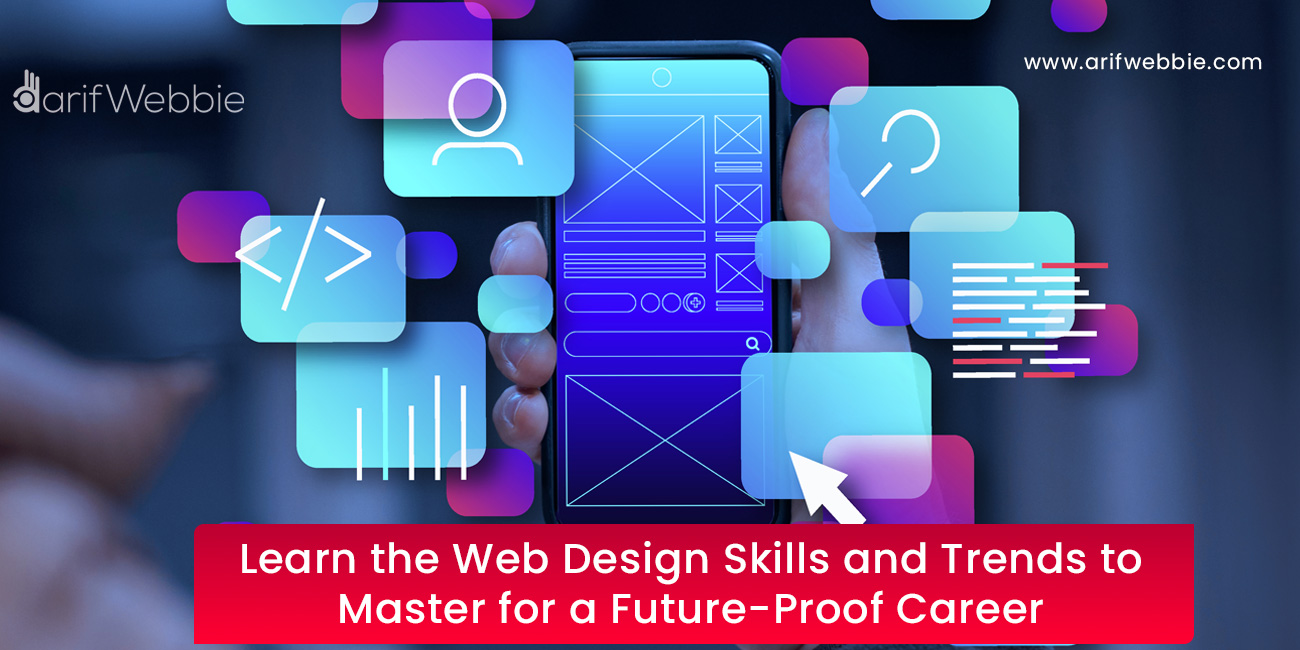Before diving in let’s explore Why Web Designing is the Future?
In this digital world, most businesses rely heavily on a strong online presence to connect with their audience or customers. One can consider a business without a strong online presence risks being invisible. This makes website design one of the most in-demand skills of the decade. But just being relevant as a designer is not enough. To remain in this competitive world, one has to learn the basics to stay ahead of the curve.
By 2026, developing design practices, which meet the user expectations, and upgrading ourselves to learn new technologies will set the bar at peak for all professionals in web designing. The future journey in this profession is all about shaping user experiences, brand identities, and customer trust. As the companies look forward to investing in websites that are fast, user-friendly, and visually compelling, the demand for skilled professionals in this profession will only grow in the coming days.
Well, considering you’re thinking about starting or growing your career in this field, I do hope this guide will help you to explore the key skills needed to learn and upgrade to trends that are going to shape the industry’s future, which is the only way to build a career that remains pertinent in this profession of website designing.
So guys, the question here is not only whether to keep learning, but also what to master and how to stay ahead. Let’s dive in!
The first practice Every Web Designer Must is to ”Master Core Skills”
The first practice that every web designer should focus on is to master their core skills. For true professionals what sets apart is having a strong foundation in learning web design principles which is important even before exploring advanced trends, tools, or flashy features. To achieve the core skills that can ensure the designs remain functional, user-friendly, and adaptable across all different platforms the designers have to understand typography, color theory, layout design, usability, and accessibility that is must for every web designer. Just think of a builder who needs a solid base before constructing a skyscraper, similarly every designer needs these fundamental skills to create websites that deliver real value to users and businesses besides looking awesome. Below listed are a few of the skills that contribute to building websites which are not only visually appealing but also effective, searchable, and future-ready.
1. Responsive Design
What a Modern user expects today as the first and the foremost important thing is to have a seamless browsing on different devices whether they are on desktops, tablets, or smartphones. It’s a must today! A responsive website design is no longer optional as more than half of the global traffic is coming through mobile. In the coming age, we as designers must shine at creating flexible grids/sections, using flexible images, and ensuring that websites maintain high performance across all different screen sizes and devices.
2. UI/UX Fundamentals
Any Great design only starts with the user. The heart of any website design is by crafting a clear navigation menu, intuitive layout, and simplified interactions. Some of the research-based techniques like wireframing, prototyping, and A/B testing to align user expectations with brand objectives will be considered best to learn for rising UX designers. Today, the users are seeking more engaging digital experiences, for which emotional design will play an increasing role in web designing.
3. Expertise in Design Tools
By 2026, the core go-to tools required for real-time collaboration and prototyping will be Figma, Adobe XD, Sketch, and Canva. Hence it’s best for designers to advance from just using static mockups to creating interactive prototypes that can simulate user journeys. For designers, in coming years merging design and code seamlessly by using tools like Webflow and Framer will gain traction.
4.Coding Literacy
It’s a known fact that many designers today rely on visual builders for building websites, but learning the basics of HTML, CSS, and JavaScript can bring greater flexibility and innovation in your career. Having a knowledge in coding can bridge the gap between design imagination and technical execution, which can ensure your collaboration with developers or even to implement custom solutions that can stand out.
5. Creating a SEO-Friendly Design
Search engines consider not just content but also design elements when ranking websites. Designers must learn how website structures, internal linking, and site speed directly influence SEO. Skills like image optimization, schema integration, and adopting Core Web Vitals (Google’s performance standards) will directly impact design success by 2026.
6. Accessibility Design
Accessibility is central to accepting diversity. Every designer has to adopt frameworks like WCAG (Web Content Accessibility Guidelines) that can ensure everyone, including those with disabilities, can navigate websites effectively. Skills like using color contrast ratios, screen reader compatibility, and focus state designs will be crucial in every website design project.
Web Designing Trends for Future
Innovation, sustainability, and user-first experiences for the future of web designing as these design trends will shape in the next few years about how a website can look, feel, and function.
Artificial Intelligence and Automation
AI is already stepping into design with automated layout suggestions, AI-powered wireframes, and even text-to-image generation. By 2026, we can expect AI-assisted web designing to cover everything from automated coding to real-time personalization, enabling designers to work faster without sacrificing creativity.
Immersive 3D and AR Integration
As businesses move towards interactive storytelling, 3D graphics and augmented reality (AR) features will dominate. For example, eCommerce websites will allow customers to preview products in 3D or visualize furniture inside their homes using AR. Mastering tools like Three.js or WebXR will be vital for designers who want to stand out in immersive website design.
Minimalism and Fast Performance
The trend of “less is more” isn’t going anywhere. Websites that load fast, use fewer heavy graphics, and prioritize clear visual hierarchies will lead the way. By 2026, this will merge with performance-driven priorities such as lightweight coding, CDN usage, and optimized hosting to deliver minimalism without compromising user satisfaction.
Dark Mode and Theme Personalization
Today’s users want control over their digital experiences. Light/dark mode options are now standard across applications and websites. By 2026, websites will offer multiple theme options, letting users customize visuals according to preference, which boosts engagement and inclusivity in web designing.
Accessibility-First Designs
Accessibility will no longer be just a compliance requirement but a brand differentiator. Websites that are inclusive will not only reach wider audiences but also achieve better SEO rankings, as search engines prioritize accessibility. Expect website design to be deeply tied to inclusivity through AI-driven voice interfaces, sign-language avatar integrations, and improved assistive navigation.
Sustainable Web Design
With environmental concerns growing, sustainability in digital projects will gain traction. Sustainable web design focuses on reducing the carbon footprint of websites through efficient coding, green hosting, and renewable energy-powered servers. Designers will increasingly be asked to plan for lightweight assets, reusability, and eco-friendly principles without losing creative edge.
Personalization at Scale
By 2026, websites will dynamically adapt to individual preferences. From AI-driven product recommendations to adaptive layouts, personalized websites will drastically reduce bounce rates and increase conversions. Designers must pair their creative skills with data-driven personalization tools for competitive advantage.
To stay ahead in web designing, it’s not enough to know trends—you need to apply them strategically and consistently. Below is an expanded, more in-depth version of your points with actionable insights.
Continuous Learning
Web design is evolving constantly as new technologies, devices, and user expectations emerge.
- Enroll in structured programs: Specialized courses on UX/UI design, motion design, or advanced tools like Figma, Webflow, and Framer can sharpen your practical skills.
- Certifications & Microlearning: Platforms like Interaction Design Foundation, Coursera, and Google Design Certificates add credibility. Short modules on emerging practices (e.g., accessibility design or dark mode optimization) keep learning bite-sized and manageable.
- Join professional communities: Engage on forums like Designer Hangout, IndieHackers, or Dribbble to learn through peer discussions. Online hackathons or design jams expose you to fast-paced problem-solving.
- Case study analysis: Study award-winning projects on Awwwards or Behance not just for aesthetics but for strategy—what problem did they solve, which patterns worked, and why?
Experiment and Build
Practical application sets you apart from those who only follow trends.
- Portfolio projects: Don’t wait for client work—design and build conceptual websites. For example, try a travel landing page optimized for micro-interactions or an ecommerce store that plays with augmented reality (AR) product previews.
- Prototype fast: Use tools like Figma and Webflow to test out your ideas quickly. Experiment with different typography systems, color psychology applications, and usability-focused layouts.
- Explore immersive tech: Integrate AR/VR mockups, voice user interfaces, or AI-driven personalization into demo projects. Even if these aren’t mainstream yet, showcasing them shows clients that you’re future-ready.
- Iterate publicly: Share work-in-progress on social platforms to gain feedback from peers and position yourself as an evolving designer, not just a finished-product deliverer.
Collaborate with Web Developers
Design and development are increasingly intertwined—clients expect seamless experiences.
- Learn core coding languages: HTML, CSS, and basic JavaScript are essential to understand feasibility, optimize design handoff, and improve cross-team communication.
- Understand frameworks: Gain familiarity with libraries/tools like React, GSAP animations, or Three.js. Even if you don’t code fully, knowing their capabilities helps you design within realistic boundaries.
- Design-to-dev workflow tools: Practice seamless handoffs using Figma Inspect, Zeplin, or GitHub repositories where design changes sync with engineering needs.
- Empathy for development challenges: By understanding scalability, performance, and accessibility from a developer’s perspective, your designs will be more robust and functional.
Follow Industry Updates
The design ecosystem shifts every year—staying informed ensures you can apply new methods before they become standard.
- Dedicated design portals: Read Smashing Magazine, UX Collective, and Codrops for tutorials and emerging concepts.
- Inspiration platforms: Regularly review Awwwards, Behance, and Dribbble to benchmark visual quality and gather creative references.
- Newsletter culture: Subscribe to curated newsletters like Sidebar, Web Designer News, or DesignModo Weekly for bite-sized updates.
- Podcasts & YouTube: Channels like Flux Academy or podcasts like Design Details often reveal practical tricks that aren’t in written blogs.
- Trend Reports: At year’s end, review “Web Design Trends Reports” to anticipate where aesthetics and usability will head in the coming year.
Get Client Feedback Early
Note that solving a real world challenge is when a web designer can become more valuable.
- Prototyping with clients: One way of getting the feedback is by sharing clickable prototypes instead of flat mockups, for which tools like InVision or Figma’s prototype mode can allow clients to interact with the proposed site.
- Structured feedback loops: Setting up milestones like wireframe review, first draft, functional prototype can help in getting the feedback, so that corrections can be made at the early stages instead of late.
- Client workshops: Running brainstorming or wireframing sessions with clients can make the clients feel invested and help in co-creating the direction together.
- User testing: Get the actual users opinions alongside client opinions to perform test tasks on prototypes. Also by recording sessions (heatmaps, click tracking) helps reveal usability issues that assumptions miss.
- Iterative refinement: Build client trust and ensure relevance in your process by demonstrating improvements and applying feedback quickly
By working on these strategies together, you can elevate yourself beyond aesthetics and become a strategic digital problem-solver. Someone who designs not just for beauty, but for performance, innovation, and business impact should be the main idea.




No Comment! Be the first one.